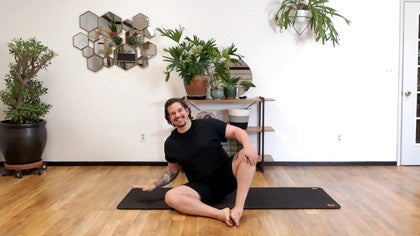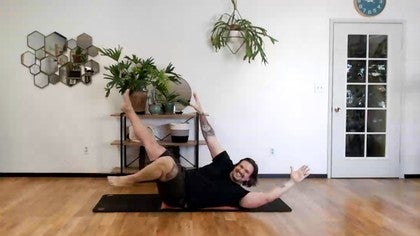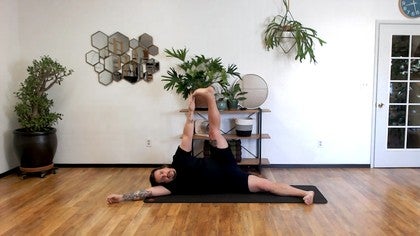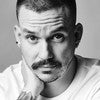Description
About This Video
Transcript
Read Full Transcript
Welcome everybody to Pilates Anytime Live. I'm James Crader and we're gonna have a restoring self-trust experience. We're gonna get started with some nervous system toning exercises, work our way through some movement, and end up in some Pilates-ish movements today. Hopefully you stay with me over the next eight weeks, 'cause we're gonna have a really, I think, incredible series and hopefully you do too. So without any further ado, let's get started.
I want you to just sit or be comfortable, whatever that means for you. And we're gonna get right into some nervous system work. Bring your hands together, get them warm. It's chilly in my room today, so I gotta do some extra warming. Once they are warmed up you're gonna take your warm hands, you're just gonna put them on the front of your throat and you're just gonna be here, that's it.
Everything you're gonna do today, here's what I want you to understand, everything you're gonna do today you cannot get it wrong. You can't get it wrong 'cause there's not a right way to do any of this. So with these warm hands you're just experiencing warmth in a really important portion of your body, the front of your throat. So just be there and just relax, it's all you gotta do. Then if this feels really good for you, stay here, do this thing, pause, enjoy this.
If you wanna move on, I'm gonna move on. I'm gonna take my right hand to the front of my left throat. And I'm just gonna heavy-handedly drag this towards the midline as I twist my face towards the left then I'm gonna take my left hand, right throat, drag as I twist. Right hand, left throat, drag and twist. And drag and twist.
From there, I'm gonna take just a couple of fingers, I'm gonna put them on my jaw, and I'm just gonna do a little jaw massage. Again, whatever feels good for you. The nervous system is just responding to feel good moments. So, again, you can't get it wrong. There's not a place to put your fingers.
I'm gonna continue along the jawline. So liberating to know that there isn't a wrong way or a right way to do it. Then I'm gonna just go down the front of my throat, I'm gonna get to my collarbone, just a little massage there. My massage is gonna turn into tapping. You decide, do you wanna tap?
Do you wanna massage? What feels good for you? I'm gonna take that tapping all the way into the chest. For me, I'm gonna turn that tapping into some arm slaps. Just kind of waking up the body saying, you know, it's time to wake up elbow, armpit, hand.
Other side. All the way around. Maybe in my back, maybe in my legs, maybe I'll even just kind of go here with it. The slapping is gonna become shaking and I'm just gonna shake everything out. Our body holds on to all of the molecules of stress, all of the chemicals of everything you live through.
So what I'm doing in my imagination is I'm literally shaking off life from the cells, getting everything fresh. So just shake. It can just be one hand. It can be two hands. It can be the whole body.
Whatever it is. Then I'm just gonna stick my legs out and I'm just gonna shake. Just kind of shaking everything off. Can just be kind of fidgety. It can be rhythmic.
You decide Can't get it wrong? I'm gonna collect myself and I'm just gonna kind of rock for a moment. As I rock, what I'm telling myself is can my spine, can the trunk of my body be representative of seaweed or kelp or bamboo in the wind. Whatever visual works for you, totally fine. But you're just sort of saying, do I have access to a soft, movable spine today?
Once you've had enough of that, and by all means, if this or one of the previous ones feels good to you, revisit that, be with that. Also remember these things, because as we move and if and when things get more complicated and your nervous system gets kind of stirred, you feel that low grade stress fever spike a bit, maybe return to these. If you're living life and you feel stressed maybe you remember the one of these warmups that felt really good and just play with that for a moment. Then I'm gonna find my center, I'm gonna just drop my head. I'm not even gonna think protocol or dos or do nots.
I'm just gonna drop my head and I'm just gonna kind of swing my ear to the right and then swing the left ear to the left. And just swinging it. Thinking of my head as a pendulum and just letting gravity do some work. Then I'm gonna allow that to shift my posture. Maybe I sink and lift.
Maybe I sink and lift. You decide what feels good for you. I'm gonna now do that and look over a shoulder and sink and look over the shoulder and over the shoulder. That way there's a rhythm there and there's sort of some three-dimensional movement. I can use my arms or if I want, it can just be small.
I like big for today. For two, and one. Then come back to your center, bring the soles of your feet together to the best of your ability today. I call this one, I don't know what the name is, I think it looks like a butterfly. So just do the little butterfly legs, whatever works for you.
Just getting some movement. Ah, and then maybe some rocking. Here, can I allow the hip joints and the legs to move? You kind of notice there's like, you know, a little bit of that butterfly motion, but I'm also now integrating that soft spine with all of this. We're gonna return to something very similar to this later.
So if you already find this stirring for your nervous system, this might be an alternative when we get to falling practice, which we will. Then just slide your legs out in front of you. From there, you're gonna take your left hand, I'm gonna kind of turn like this, so you have a better visual of what is going on. You're gonna take your left hand, you're gonna move it behind you somewhere. You're gonna turn your eyes to look for said hand.
It's gonna lift the hip and you're in sort of a twist here. Look at your hand, push the floor away, take a nice, deep inhale. Exhale, sitting back down, allowing yourself to twist, twist, twist. Right hand goes behind you. You literally look for it.
You allow your body to twist and you take an inhale. Exhale, regrounds sits bones, brings you forward, immediately left hand. Exhale, right hand. Ah, one more each side, 'cause I love this one. Ah.
Ah. Now, again, sitting comfortably, just take and pull your shoulders up into your ears and then let them drop. Wherever they go, they go. They go up, there's tension, you're purposely bringing them up, and then relax. There's it up and a relax.
Up and a relax, and an up and a relax, up and relax. Now, you can keep doing that thing, or you can just kind of move one shoulder. I think of it as what if the shoulder came alive on its own and had its own wants and its own needs. Where would this shoulder go? And what would it bring along with it?
You can think shoulder blade, you can think collarbone, you can, whatever it is. I think of it like what if my little pet shoulder just wanted to move. Just wanted to kind of play. Where would it go? Maybe it would go down.
Maybe it would go up. Maybe it would go back. Where does it want to move? How does it want to move today? Maybe it wants to go forward.
Then other side. And I think we spend a lot of time thinking about where we should be moving or what should be moving. And I'm just advocating for maybe we listen to how the body is called to move in the moment. And it can start with something as silly looking as this. Maybe I just kind of even let it move.
Where does it wanna go today? How do you wanna move today? It's like a little shoulder dance. Then just find yourself in center for a moment. We're gonna go into a breathing practice.
And here's one thing I know for sure about breathing practices. If you feel like you are going to get the breathing practice wrong it makes you more stressed. So I'm gonna guide you through a Dr. Andrew Weil's four, seven, eight breath and I'm gonna take it into a James Crader original, which is listening for breath. That's how I think of four, seven, eight. By all means, if this doesn't work for you just do the breathing practice that works for you.
Okay, get yourself centered, relaxed, whatever that means for you. Take in an inhale and then let out an exhale. You're just gonna do a few more cleansing breaths. Four, seven, eight. I will count, you breathe.
We're gonna do an inhale to a count of four, holding our breath for a count of seven, exhaling for eight. Four, seven, eight. I'll count, you breathe. Can't get it wrong. Ready?
Nice, cleansing inhale, exhale. Everyone together is gonna do an inhale to a count of four, three, two. Hold your breath, seven, five, four, three, two. Exhale, eight, seven, six, five, four, three, two. Inhale, four, three, two.
Hold your breath, seven, six, five, four, three, two. Exhale, eight, seven, six, five, four, three, two, one. Four, three, two, one. Seven, six, five, four, three, two, one. Eight, seven, six, five, four, three, two, one.
Short inhale. Buoyantly hold your breath. It's like you're floating on that hold. When you feel ready, you're gonna exhale and deep dive, relax, sink into that exhalation. Holding it underneath the exhale, listening for when your body wants to inhale.
Short, quick inhale, hold your breath, buoyantly float. It's like you're floating in a pool. Exhale, you sink, you deep dive into that exhalation. You hold your breath. You listen for when your body is called to breathe.
Short, quick, inhale, hold. When do you want to exhale? How do you want it to feel? What's the mind state of exhalation. Go ahead and do it.
Hold. And do two more of those on your own. You can't get it wrong. It's a short, quick inhale. So holding your breath, and then it's a relaxed exhale.
Just give it a go. When you're done, just take a pause, take a little personal inventory. How do you feel right now? What of those practices felt really good, really nourishing? What are you gonna take with you forward?
What are you gonna leave behind? What just did not work for you? It's not about the tools. It's about your experience with said tools. From there, slide your legs out in front of you.
I'm gonna go this way. Get your hands warm again. Put your hands on your legs. Imagine that your hands have just become paint and you want to paint your legs in the direction of your feet. And then you're gonna come back up.
Now, you just painted a line. Instead of resaturating the line, paint somewhere else on your leg and maybe paint somewhere else on the way up. Maybe it's the back of the legs. Now, with that, can your head be the first thing to relax and the last thing to come back online as you come up. My head relaxes, I paint my legs, whatever I reach, I reach.
I come back up, my head and my neck are the last thing to come back up. They're first thing to relax, it's conscious, and they are the last thing to come back online. Two more of those. One more. And we're all the way up.
So go ahead and lie all the way down. And we're here. And just for a moment, appreciate that the actual ground is supporting you and you can just allow yourself to feel and be supported by the ground. Let gravity do her job and just pull you and just be there and enjoy that. Can you enjoy being supported without critiquing what feels heavy?
What feels light? Am I doing it right? Right. Got to get out of that fix it mindset and just be with, oh, look at that. Like that side feels lighter, that side feels heavier and that's okay.
From there, you can just be here or drop your knees to one side and drop your knees to the other side. And I invite you to just begin to explore what is the difference between going left and going right? Rather than thinking, oh, I'm tight over here, which is sort of qualitative. You're just noticing like, oh, look at that. Like, it feels different over here and it feels different over here.
Now, I'm gonna drop my knees to the right. I'm gonna open my arms to the letter T. I'm gonna take my left hand and reach it over towards the right hand. From there, I'm going to let my knees come back first, and then my arms open up. My knees are gonna move first, then I'm gonna do an arm movement.
Then I'm gonna bring my knees back and I'm gonna bring all of me back. My knees move and then I move. My knees move, I move. One more, knees and then me. Knees and then me.
From there, let's do a little bit of cross body connection. Right arm, left leg touch, and then they go back. Left arm, right leg touch. Now, here's the thing, you are clinically making yourself smarter, waking up the nervous system by just having one side of your body touch the other side of the body. So this is enough.
You can just do this. You are making yourself smarter. Or you can go, huh, I wonder how many different parts of an arm can touch how many different parts of a leg. Maybe it's a hand to a ankle. Maybe it's an elbow to a knee.
Maybe I have back of a hand to the thigh. I mean, so many different options. Two and one. Go ahead and be there. Now, do a couple of bridges.
However it is you know to do a bridge. So I'm just gonna lift my hips and I'm gonna come back down. I'm gonna lift and I'm gonna come back down. One more just so you can take an inventory of what a bridge feels like. Now, I have a cardinal rule of movement.
In order to go up something's gotta push down. So I'm gonna think, hands and feet push the floor away, and therefore I go up. I decelerate back down by gradually pushing the floor less. I push to go up, I decelerate and push less to go down. Now, check in.
Are both feet pushing in ways that feel enjoyable to you? How about your arms? Guaranteed there's probably one side of your body that is not doing the same thing as the other side. And you already know that from dropping right and left and exploring. You have two different sides of your body and that's totally okay.
What do they need? For me, I like to move my left leg slightly out to the left and my left arm more out to the left, so that I'm not symmetrical. And when I lift, I now feel everything coming online in a very different way than if I had stuck to symmetry. So this is me giving you permission to figure out where in space do you need to be in order to push to go up. Two more of those things.
I push. And one more. I push. And I come back down. Bring your knees into your chest, go ahead and roll over to one side.
Go ahead and roll over to the other side. And roll, roll. It's that simple and rest. All the way over. Great, all the way over, all the way over.
Now, go ahead and pick a side to be on. I'm gonna pick this side, so that I'm facing you. Make yourself into the longest shape you can possibly be here, lift your arm up towards the ceiling. That top foot is going to come all the way up and touch your hand and back down. So the foot has to touch the hand.
It's a task. Now, with that, no one said you had to keep your leg straight. Maybe this works for you. Maybe you need to kind of roll back. Maybe your hand needs to be somewhere different.
Wherever it is, we're experiencing tasks. My foot is gonna do a job. It's going to come up and touch a hand. 'Cause that's all movement is, is a series of tasks. Exercises are movements with a whole bunch of rules around the tasks.
So just figuring out what's the thing I'm supposed to be doing here? Well, my foot is to touch my hand. One more. Then bend that knee, grab ahold of it, put a little stretch on it. You can just hang out, just be here, do a little stretch.
Take a couple of breaths. Nothing fancy to see. Then top leg is gonna reach backwards, top arm is gonna go forward. Then they're gonna exchange places. Exchange again and again, again and again.
One more. Other side. So just flip on over and you know the rules here, it's a series of tasks. What is the thing I'm supposed to do with what part of my body? What it ends up looking like is totally dependent on your anatomy and your history with movement.
Mine looks like this. Yours might be different. In fact, today, I wanna be here. This just feels good for me today. For three and two and one.
Bend my knee, do my very unsexy stretch, just relaxed, hanging out. Then I'm gonna let go of that leg. It will reach backwards, arm will go forward and they will exchange. You can see we've been practicing or experiencing a lot of twists. The nervous system loves a good spiral.
One more. Roll onto your belly. I'm gonna roll this way just so that you get an idea of what this can look like. So we're gonna come down onto our forearms here. Good.
And you're gonna be here and you're just gonna start swaying. Now, from the side I like to let it move my entire body. Again, you can't get it wrong. We're back in that idea of seaweed spine. We're just allowing the spine to get a little supple movement.
Play with that. Play with just allowing the bones to move, the internal organs to move. Just being here with that. Now, that might be enough for you. I like to then take it, at this studio we call it baby lizard arms.
So you're gonna take your arms outside of your mat, like so, got it. We're gonna be here and we're gonna just do our movement. Can you allow the head and the whole body to move? From there, I lift up into some extension. My shoulders get to move.
I get to come back down. I get to go back up. I get to go back down. And I get to go back up. And all the way back down.
Spend some time on the belly. Spend some time on the belly feeling supported by the floor. We did that on the back, but acknowledging that the floor is there to ground and support you. Just let yourself be held for just a moment. Take a couple of breaths.
Now, choices. You can be there, you can revisit any of the stuff we've played with so far, or you can follow me forward. If you're ready, go ahead and bring yourself back up. We have primed the nervous system, practiced some breathing, we have warmed up the body in a lot of different ranges of motion. Now, let's practice falling.
Let's just get to it and I'll talk about it. You're gonna take your left arm, reach it out. You're gonna fall over, touch the floor, and come back. Right arm, it starts here. Just practicing my falling.
Now, if this leg position doesn't work for you go here, go here, go here. There's not a right way to do it. You're just sort of playing with this. Now, the reason falling becomes really important is humans, pathology aside, have two natural human fears that we're all born with. Number one is fear of falling.
Number two is loud noises, pathologies aside. Fear of falling and hurting yourself is the most restrictive component of a movement vocabulary. Meaning that if you're afraid of falling you're not gonna take chances. If you don't have strategies or an experience with what it feels like to come on balance and off balance you are not gonna take movement risks. So if we practice falling in this really safe, compassionate, fluid way, chances are you, your clients, your friends, your family, your moms, your dads are all gonna take more movement chances and increase your movement vocabulary.
And it can start here. Then how long can you keep your hand off the floor? That might be stress feverish to you. That might bring something up. Maybe you want a different leg position.
Maybe you want two hands. I like to do this one. This is where my practice is, so if you are familiar with my work, follow me here. Falling, no arms. Yep.
You're just practicing falling and surrendering to the floor, that simple. Now, if that strikes you as nope, just go here, do this thing. If you're ready for the next level, level up by changing leg position. So we'll be here. By no means is this saying, you've gotta do this now.
If that falling on the floor is enough, stay there. If not, practice falling from here. Now, we've already learned some tools today. Maybe I need to track with my eyes. Where is that hand going?
Maybe I need a fluid spine, just allowing myself to drip side to side. Maybe I need both hands. If you feel yourself get stirred, maybe I just go into some tapping, some breathing, bring myself back in or continue. From there, maybe you wanna stay here or maybe you wanna come up. Level it up a bit and can you begin to fall from here?
We can just keep it safe for a moment, but you'll notice I'm naturally going into our next lesson. I call this lifting of the leg, liberating that leg. I don't think about where it has to go. I just allow it to go somewhere as a counterbalance. Liberating a limb to allow the whole body to figure it out.
Not gonna create some extra rules until I need to. Now, I've been falling a lot side to side, but I can fall kind of forward. I can fall back. I can go way forward. I can go down and over.
I can fall to the side and up and all the way up and over, lift, liberate a leg, come back, fall. Have a little fun with it. How can you begin to string together this little bit of falling practice? Where does it take you? Now, how is it different if we not only use our hands to decelerate, but we also invite a leg?
Maybe I fall, I come up and I catch myself with a leg. And I just allow myself the freedom of playing on the floor. And then settle in. Take a nice deep inhale. Maybe go back in, recenter.
Breathe, collect. Get a sip of water if you need it. Then, let's go to the mat again. From there, we're gonna move this mic yet again. Bring your knees towards your chest and I want you to just sit up and then relax.
Sit up and relax. Sitting up. I gotta relax my neck to relax my spine. Now, that might be enough. Or maybe I relax and I practice lifting legs and just can I center myself?
Rock back up and up. Maybe I want more. Maybe I go back, so far back that I come back up, balance, set my feet down and come up. Very non-precious. If you're doing rolling like a ball, please just stop and just give yourself permission to go, ah.
Lift, fall, up. Look at me, relax. Up. How can this experience inform your rolling like a ball, so that there's less tension, there's more play. There's more awareness of moving in and out of balance.
Maybe I even do this and kind of roll through the left body. Maybe I roll through the right body. Playing on and off center. How does it change if I just simply make a different choice with my arms? What am I learning about how I perceive movement by just making a different choice?
One more. Slide your legs out in front of you. Your task is to get to your toes, hands to toes. So you may have the flexibility to get there or no one said you had to keep your legs straight. Maybe you need that.
Maybe you need one leg bent, one foot straight, then switch. How do you need to touch both sets of toes? Now, maybe that's enough for you. Maybe that feels like already a lot. Stay there, play with that.
If you'd like more, maybe I touch my toes and I lay down. I make myself relaxed and big. Then I figure out how to come back up and touch my own toes. I relax. I come back up.
If you're doing roll-up, please stop. Just allow yourself to play for a moment. There are my toes. I've been asked to touch them and figure out how to lay down. I'm now asked how do I come up out of lying down and touch my toes.
Maybe I need to take the side street. Maybe I need some help. Maybe I gotta bring a leg with me and bring myself back up with that thing. What choices can you make in your own movement to start building some self-trust? That, oh, that decision I just made was the right decision for me in that moment.
It doesn't mean that it is the right decision. It means it is a decision you've made in the moment that feels right. One more of doing whatever it is you're doing there. Ah, from there, let's go ahead and lay all the way down. Let's take a leg journey for a moment.
You're gonna lift one leg up and you're gonna point and flex and make some circles. I want you to look at your foot. I want you to get really amazed by that foot for a moment. Like, look at that, that's my foot. It can do all of this cool stuff.
Look at that, that's a knee and that's a hip and it can do all of this really cool stuff. Look at that. Now, you can be there doing that thing, or you can make a circle. No rules, just a leg circle and then reverse. Now, if that feels good or important, stay there.
I'm gonna go further. I'm gonna say how big of a circle can I make? And maybe, and I've got things in my way over here, but maybe I let my whole body go with it. There's no rules here other than what feels good. Then reverse.
No rules, what feels good? Then, here we go. Lying here, lift that leg up. How big of a circle can I make with that leg without moving anything else in my body? And can I do that from a nervous system relaxed state?
Ah, fully relaxed. And then reverse. Relax, be there. Notice your body, notice the information, notice what it has to say about what you just did. Then lift the other leg, point, flex.
Get imaginative, let yourself be inspired by your own leg. It's like, look at that, look at all that cool stuff it can do. Then maybe there's some circles. How was this leg different? Then it's a great big circle.
Great big. And reverse. Great big circles. Now, last one. As you recall as big of a circle as you can get, fully relaxed, nothing else gets to move.
One more. Knees into chest and rolling. Just relaxed. Maybe I roll up, stretch my legs, touch my toes, bring my knees back into my chest, relax. Up, slide, up.
Can it be fun? Think, I'm a kid and I'm just having some fun. Maybe I even liberate the legs. Maybe my legs go wherever they wanna go. One more.
And up. Beautiful, from there, join me up on your knees. Now, again, we're not doing Pilates, we're just playing. Let's put together some of the stuff we've been practicing. You're here.
You're gonna reach your favorite arm out to its side. You're gonna fall into that arm and liberate a leg and back up. Fall and liberate. Fall and liberate, fall and liberate. From there, how about you fall liberate and get real big.
Go small, come back up. Go big and go small. Feel the softness in that fall. And if it feels good, maybe you stick it. And maybe that leg out there starts to move wherever it wants to go.
If you're like, I don't know where it wants to go, create a task. Maybe that foot touches one hand. Can it touch the other hand? Ah. Then back up.
Maybe it touches a foot, maybe you see it, maybe it disappears, maybe it just plays out there for a bit. When you're bored, come back up, other side. Liberate that limb. You can give it jobs or just explore. Ah, work your way back up.
Back into some falling, but we're gonna give it purpose now. Face into your mat. You are going to sit back. You're gonna come up and you're gonna fall forward. Go down, push up.
Woo, back up, sink back. I come up, I fall, up. Ah, up, fall, up. Now, can I do that, but slightly to the left? Letting out sighs, let your body express.
One more of those. Ai-yai-yai. Beautiful, culminating experience. We have moved our nervous system, we've moved our breath, we've moved our body, we've kind of played with movement. Let's do a really, really human thing here at the end.
Sit. Whatever that means for you. Then stand up. Be here in standing. Sit back down.
Stand back up. Sit down. Stand back up. Ai-yai-yai, sit and stand. Sit and stand.
Go ahead and sit and stand. One more, sit and relax. Good. Ah, take a nice, deep inhale. Let yourself fully, fully relax.
I always end all of my classes the same way, always. Place both hands on your heart. Be there, feel your heart in your hands. Take a nice, deep inhale. Tell yourself thank you for being here today.
Take a look around your room, your space, your mat, the floor, everything in the space. Tell your space thank you. You literally could not have done it without the ground, without the room, without the space you're in. Take a look at your community. Whether that is someone in the room with you, a dog, a cat, a bird, or anyone here on-screen, anyone who's joining you from anywhere in the world.
Even if you're watching this later, thank you for being a part of our community. We could not do this without you. So self thank you, space thank you, community and other thank you for being here. We truly, truly appreciate it. I'm James Crader, this is Curious Movement Pilates Anytime Live.
I'll be here for the next, what is it? Seven weeks. Hopefully you come back. Today was all about the nervous system. We've got a huge exploration ahead of us all about restoring self-trust.
We've got some sense stuff, we've got specific body parts. And at the end, the culminating experience is taking all of this and integrating it into a Pilates class. So I invite you back. So, so happy for you to be joining us and thank you.
Mindful Movement: Curious Movement
Comments
You need to be a subscriber to post a comment.
Please Log In or Create an Account to start your free trial.















































